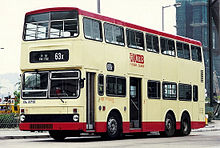Metro Cammell Weymann

Metro Cammell Weymann , MCW for short, was one of the most important manufacturers in the British transport industry. The company was founded in 1932 and existed until 1989.
history
Metro Cammell Weymann went out in 1932 from the merger of the body construction company Weymann Motor Bodies Ltd. and the Metro Cammell department responsible for the manufacture of bus bodies. Like its predecessors, the company manufactured bodies for buses . Until the 1980s, it was common in English-speaking countries that chassis and superstructures for buses were manufactured by different manufacturers. As a result, the wishes of the operators of bus routes could be better taken into account and the buses built according to their specifications. The types developed by the body shop were used for the chassis of various manufacturers. It was only from the 1970s that the trend towards the integral bus with self-supporting bodies began, with the chassis and body coming from the same manufacturer. In the case of integral buses, the design and manufacture of the frame and body could be optimized, resulting in a lighter body and easier production.
The superstructures were manufactured in the former production facilities of Weymann and Metro-Cammell until 1966 . In that year the Weymann plant in Addlestone was closed and the Weymann brand name was given up at the same time. From 1977 the company also manufactured chassis for buses. With superstructures for the Daimler Fleetline , the company was able to secure large orders from London Transport . Entry into this market was already successful with the low RLH double-decker buses , which were manufactured from 1950 . Other major customers were Merseyside , Tyne & Wear and West Midlands PTE .
The Transport Act 1980 saw a deregulation in front of the bus traffic over distances of more than 30 miles, which led to increased competition. There was a growing trend towards heavier chassis, better suited for longer mileage and higher speeds. The 1985 Transport Act deregulated internal passenger traffic. As a result, the volume of traffic decreased, so that double-deck buses with high seating capacity were no longer needed on many routes. There was a growing trend towards heavier single-deck buses, the capacity of which was higher than that of the single-deckers built to date, but below the double-deckers, and which were better suited for longer mileages and higher speeds in regional traffic. As a result of the deregulation, the sales figures of many British manufacturers in the bus industry declined. In 1989 the Laird Group , to which MCW was now part, decided to sell the company. Since no buyer could be found for the entire company, the product lines were sold individually. The Metrorider went to Optare , a company that had emerged from the body shop of Charles H. Roe . Optare continued the production of the Metrorider as the MetroRider . The design of the Metrobus was acquired by DAF and Optare , with DAF taking over the chassis and Optare the structure, which was redesigned and launched as Optare Spectra . The design of the Metroliner also went to Optare , but the structure was no longer produced. The Taxi Metrocab was taken over by Reliant . Metro Cammell's production of rail vehicles went to GEC Alsthom (now Alstom ).
Models
Superstructures
- still from Weymann: single- decker and double-decker buses on different chassis u. a. AEC Regent, series STL, RT and RLH for London Transport (RLH stands for Regent Low Height)
- Orion series
- Double-decker bus Daimler Fleetline as DMS for London Transport (bodies also from Park Royal Vehicles )
- Double-decker superstructure for Leyland Atlantean and Daimler Fleetline
Daimler Fleetline (DMS) to the left of an AEC Routemaster , both from London Transport
Leyland Atlantean des Tyne & Wear PTE ( Newcastle upon Tyne ) with the establishment of MCW
Chassis / complete vehicles
- Metro-Scania - semi-integral single deck bus with Scania chassis
- Scania Metropolitan - semi-integral double-decker bus with a Scania chassis
-
MCW Metrobus - double deck bus
- Mark 1
- Mark 2
- Mark 2a
- Superstructures for this bus were also from Alexander made
- MCW Metroliner - double-decker and single-decker
coach
- Metroliner - semi-integral double-decker bus with a height of 4.2 m (coach)
- Metroliner 400GT - integral double-decker bus with a height of 4 m (coach)
- Metroliner - semi-integral double-decker bus 3.2 m high (coach)
- Metro Hiliner - integral double-decker bus with a height of 3.4 m (coach)
- MCW Metrorider - Midibus





